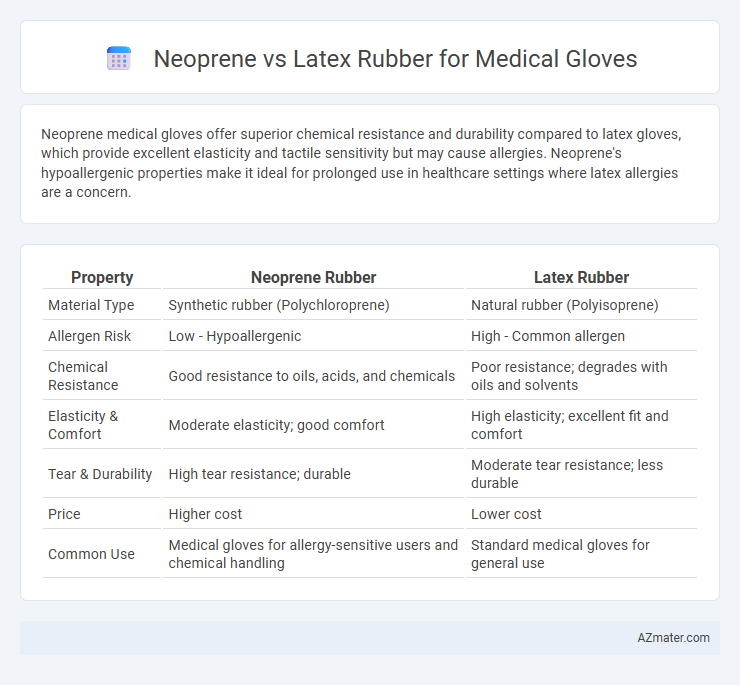Neoprene medical gloves offer superior chemical resistance and durability compared to latex gloves, which provide excellent elasticity and tactile sensitivity but may cause allergies. Neoprene's hypoallergenic properties make it ideal for prolonged use in healthcare settings where latex allergies are a concern.
Table of Comparison
| Property | Neoprene Rubber | Latex Rubber |
|---|---|---|
| Material Type | Synthetic rubber (Polychloroprene) | Natural rubber (Polyisoprene) |
| Allergen Risk | Low - Hypoallergenic | High - Common allergen |
| Chemical Resistance | Good resistance to oils, acids, and chemicals | Poor resistance; degrades with oils and solvents |
| Elasticity & Comfort | Moderate elasticity; good comfort | High elasticity; excellent fit and comfort |
| Tear & Durability | High tear resistance; durable | Moderate tear resistance; less durable |
| Price | Higher cost | Lower cost |
| Common Use | Medical gloves for allergy-sensitive users and chemical handling | Standard medical gloves for general use |
Introduction to Medical Glove Materials
Neoprene and latex rubber represent two primary materials used in manufacturing medical gloves, each offering distinct characteristics in terms of flexibility, durability, and allergy potential. Neoprene gloves provide excellent chemical resistance and are less likely to cause allergic reactions, making them suitable for healthcare professionals with latex sensitivities. Latex rubber gloves are favored for their superior elasticity, tactile sensitivity, and cost-effectiveness, maintaining widespread use despite concerns over latex allergies.
Overview of Neoprene and Latex Rubber
Neoprene rubber, a synthetic polymer derived from chloroprene, offers excellent chemical resistance and durability, making it suitable for medical gloves in environments requiring protection against oils, solvents, and moderate heat. Latex rubber, a natural product harvested from rubber trees, provides superior elasticity, comfort, and tactile sensitivity, which is ideal for medical procedures demanding precision and flexibility. Both materials exhibit distinct advantages in glove manufacturing, with neoprene excelling in barrier protection and latex favored for its natural fit and feel.
Physical Properties: Strength and Flexibility
Neoprene gloves offer superior tensile strength and enhanced puncture resistance compared to latex, making them ideal for medical applications requiring durability. Latex gloves provide exceptional elasticity and flexibility, allowing for greater dexterity and comfort during prolonged use. Both materials balance strength and flexibility differently, with neoprene excelling in chemical resistance and latex favored for its natural fit and tactile sensitivity.
Barrier Protection and Chemical Resistance
Neoprene gloves provide superior barrier protection against a wide range of pathogens and pathogens due to their dense molecular structure, making them ideal for medical use. They exhibit excellent chemical resistance against acids, alkalis, oils, and solvents, ensuring safety in environments with hazardous substances. Latex gloves offer high elasticity and tactile sensitivity but have limited chemical resistance compared to neoprene, especially against solvents and oils, increasing the risk of permeation in specific medical procedures.
Comfort and Fit Comparison
Neoprene gloves offer superior comfort and a softer, more flexible fit compared to latex, making them ideal for prolonged medical use. Latex gloves provide excellent elasticity and a snug fit, but may cause allergic reactions in some users, reducing overall comfort. Neoprene's hypoallergenic properties and comparable tactile sensitivity ensure a reliable alternative without sacrificing fit or user comfort.
Allergenicity and Skin Reactions
Neoprene gloves exhibit lower allergenicity compared to latex gloves, significantly reducing the risk of Type I hypersensitivity reactions caused by natural rubber proteins. Latex gloves are commonly associated with skin sensitization, leading to allergic contact dermatitis and more severe IgE-mediated reactions in sensitive individuals. Medical environments increasingly prefer neoprene gloves to minimize adverse skin reactions and protect healthcare workers with latex allergies.
Cost and Market Availability
Neoprene gloves generally cost more than latex gloves due to their synthetic production process and enhanced durability, making them a premium choice in medical settings. Latex gloves dominate market availability because of their widespread use, natural elasticity, and lower cost, though they carry allergy risks for some users. The growing demand for hypoallergenic options is increasing the presence of neoprene gloves in the medical glove market, despite their higher price point.
Environmental Impact and Sustainability
Neoprene gloves offer a more sustainable option compared to latex due to their synthetic composition, which reduces the risk of allergic reactions and supports longer glove durability, minimizing waste. Latex gloves, derived from natural rubber, are biodegradable but involve environmental concerns related to deforestation and pesticide use in rubber plantations. The production of neoprene typically has a higher carbon footprint, yet advancements in recycling technologies and eco-friendly manufacturing are improving its environmental impact.
Applications in Healthcare Settings
Neoprene gloves offer excellent chemical resistance and durability, making them ideal for handling hazardous materials and providing protection during surgical procedures in healthcare settings. Latex gloves provide superior elasticity and tactile sensitivity, which are essential for examinations and delicate medical tasks requiring precision. Both materials support infection control, but neoprene is preferred for users with latex allergies due to its hypoallergenic properties.
Conclusion: Choosing the Right Glove Material
Neoprene gloves provide excellent chemical resistance, durability, and hypoallergenic properties, making them suitable for medical professionals with latex sensitivities. Latex gloves offer superior elasticity, tactile sensitivity, and comfort, beneficial in precise medical procedures but may cause allergic reactions in some users. Selecting the right glove material depends on balancing sensitivity needs against allergy risks and chemical exposure in specific medical environments.

Infographic: Neoprene vs Latex rubber for Medical glove
 azmater.com
azmater.com